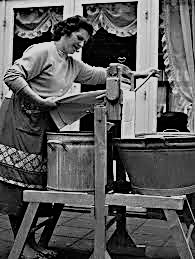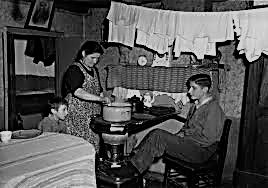
RAW HANDS
Written by Bert Plomp
In 1954, my parents received the keys to a newly built apartment in Napoleonplantsoen in Utrecht-Southeast. They were as proud as a peacock. This home was located on the third floor of the first staircase of the first block. The first block was the initial apartment building in a series of six. It was a small living space for a family of initially five and later six individuals.
All buildings had four floors. While the other five blocks on the ground floor contained two extra rooms, this space in the first block was occupied by shops. The shopkeepers lived on the first floor, above their own businesses. To prevent residents from becoming overweight, the buildings were not equipped with an elevator. It was only possible to reach your domain through the staircase.
Beyond the six apartment buildings, the park had a long row of single-family homes, stretching from the shopping square to the last apartment building. Opposite the first block, on the other side of the square, was a neighbourhood with one- and two-story homes. This part was bordered, counterclockwise, by the Kromme Rijn, the railway, and the Koningsweg.
Just like in the rest of the park, people of all kinds lived in my staircase. Firstly, the shopkeepers of the first two shops: Aunt Greet from the drugstore and the couple Van den Akker, the cigar dealer and his wife. Furthermore, a municipal official, an office clerk, a teacher, an employee of a psychiatric institution, and a police officer. All of them with their wives and children. At that time, it was uncommon for a married woman to work outside the home, especially if she had children. This only happened if the man, the breadwinner, did not bring in enough money, as was the case with my father.
With the tools available to a housewife at that time, it was also impossible to find time to work outside the home. The houses generally did not have a washing machine, a spin dryer, or other luxury appliances to lighten the workload of the housewife. Appliances like an electric oven, a dishwasher, and so on.
However, she could use a zinc washtub, a wooden washboard, and a hand wringer with a crank to do the laundry. I still see my poor mother toiling every Monday with the white laundry, the so-called ‘boil wash.’ She started by removing the worst stains, placing the piece of laundry on the washboard and scrubbing vigorously with a coarse, wet brush with green soap over the stains. The hand scrubbing took place on the tiny balcony of the apartment, whether rain or shine. In winter, her hands were blue from the cold and almost raw from brushing.
After the washboard, all the laundry went into a zinc tub with water. This heavy tub was lifted onto a burning four-burner gas stove with combined efforts. After adding some green soap and soda, my mother brought the mixture to a boil and let it simmer for several hours. Meanwhile, the entire apartment filled with steam.
The contents of the tub formed a creepy solution. Not only dirty bedding and dingy towels were the ingredients, but also underwear, diapers, handkerchiefs, and stained sanitary napkins floated in it. My mother’s sanitary napkins were treated very mysteriously. When it was their turn, my father accompanied them to the laundry boiler, behaving like a kind of secret agent. This could not prevent me from witnessing this a few times in person.
On closer inspection, the sanitary napkin was nothing more than a thick, elongated strip of terry cloth. With a cotton lace at each corner to tie and hold everything in position. That’s a whole different story than a disposable tampon or panty liner.
The tub could only hold a few sheets alongside the other laundry. Since there were about ten upper and lower sheets circulating in the house, each bed was eligible for changing every four to five weeks. Honestly, I can’t remember my bed ever being changed. Although I was a very clean boy, that probably wasn’t the everyday practice.
Around noon, the tub was lifted off the fire again. The contents were rinsed abundantly with cold water. Around that time, I usually came home from school to eat. Before I could dive into my meal, I had to help dear mother with her laundry. First, I helped her feed the rinsed laundry through the wringer and then hung it on the clotheslines in the living room.
The wringer was used to squeeze as much water as possible out of the wet laundry. This was done by pushing the damp fabric between two tightly rotating, elongated rolls. While my mother kept the rolls in motion by turning the crank vigorously, it was up to me to push the wet items through the wringer.
I was never keen on my role in wringing. Every Monday, my fingers ended up between the rolls of the wringer at least once. That was very painful, especially on cold days. Nevertheless, I remained loyal to helping my mother. After all, her hands were already so cracked from all the scrubbing.
Once the laundry was hung, the only room in the house where you could stay without a coat in winter turned into an uncomfortable, damp, chilly space. A sensation as if you were standing shivering outside in the mist on an early winter morning. If the presented food didn’t encourage this already, it always gave me a reason to devour my meal as quickly as possible and quickly return to school.
END

